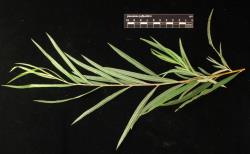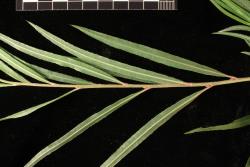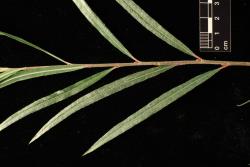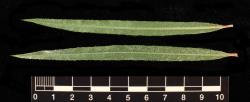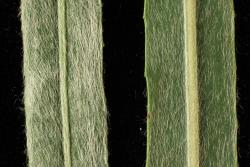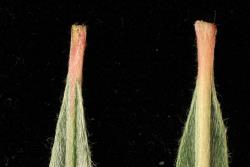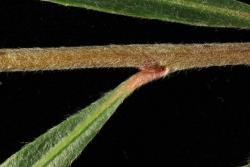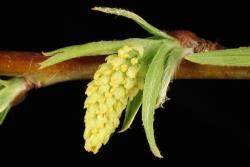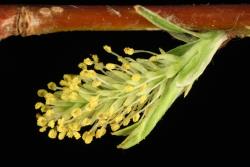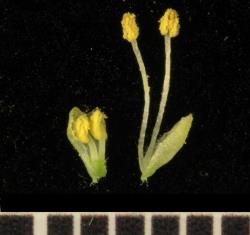- = Salix fluviatilis Nutt., N. Amer. Sylv. [Nuttall] 1, 73–74 (1842)
Habit unknown. Current year's branchlets with densely short-silky hairs, light red-brown (UCL42). Year-old branchlets strong brown (UCL55), with moderately dense, villous hairs persisting for the current year, 1.9–2.4 mm diameter. Bud scales 3.5 mm long, 2.2 mm wide, 1.7 mm deep, lanceolate, without angles, red-brown (UCL43), hairy, long-silky at base. Leaves alternate. Stipule 0.2 mm long, not persisting. Petiole 4–7 mm long, moderately densely long-silky hairy, glands absent, base of petiole not expanded, pinkish red. Emerging leaves green, moderately densely long-silky hairy. Proximal leaves distantly serrate. Leaf lamina 107–150 mm long, 7.2–8.5 mm wide, length to width ratio 13.4–18.7:1, very narrowly elliptical-oblong (linear), slightly falcate or straight; base cuneate; apex very narrowly acute; leaf galls absent; orange rust present in late summer; margins distantly serrulate, not recurved; upper lamina surface with midvein raised, dull due to hairs, densely long-silky hairy to glabrous, hairs when present denser on the upper surface than the lower surface, stomata dense; lower lamina surface midvein raised, not glaucous but pale green due to dense stomata, moderately densely long-silky hairy to glabrous. Catkins male, emergence coetaneous with leaves. Flowering branch 12–16 mm long, 5–6 leaves on flowering branch. Male catkin 9–12 mm long, 4–7 mm diameter; catkin rachis visible between flowers. Flower bract 1.6–1.9 mm long, 0.8–1.0 mm wide, pale green, channelled, curved inwards on long axis, concave; apex rounded, hairs sparse on margin only. Male nectaries 2, both lobed, 0.4 mm long, 0.3 mm wide, green. Stamens 2, filaments free, hairs absent; anthers 0.8–0.9 mm long, yellow.
Leaves are very narrowly elliptical or linear (7.2–8.5 mm wide) and the margins plane. Hairs on the emerging leaf surfaces are moderately dense and long-silky but do not persist. Male catkins are very short, 9–12 mm long, on a flowering branch 12–16 mm long that has 5–6 cataphylls below the catkin. Male flowers have two nectaries and both nectaries are unequally bilobed. Flower bracts are pale green, concave, with a rounded apex. Stamen filaments lack hairs. Anthers are yellow.
The mature leaves could easily be mistaken for those of Salix nigra, which are of similar size and shape, have a plane margin, and are the same colour on both surfaces. S. exigua differs from S. nigra in having long, appressed hairs on the current year's branchlets (which do not persist) and to some degree on the leaves, whereas S. nigra lacks hairs even on the youngest leaves. Also, S. nigra has leaves widest near the leaf base, whereas in S. exigua the leaves are widest in the middle. The long, narrow leaves are similar to those of Salix eleagnos, some narrow-leaved cultivars of S. purpurea, and early summer leaves of S. viminalis, but the leaf margins are not recurved as in those species.
Similar in leaf proportions to Salix eriocephala × S. petiolaris, but this hybrid has larger leaves (87–122 mm long, 10–24 mm wide).
In cultivation in Southern North Island (Aokautere and Massey University).
First collection: CHR 316639, W. R. Sykes, 13 October 1977, Rangiora Forest Research Institute.
First publication: This publication.
Flowering: September.
Ploidy unknown, but flow cytometry provisionally indicates PN682 is diploid.



